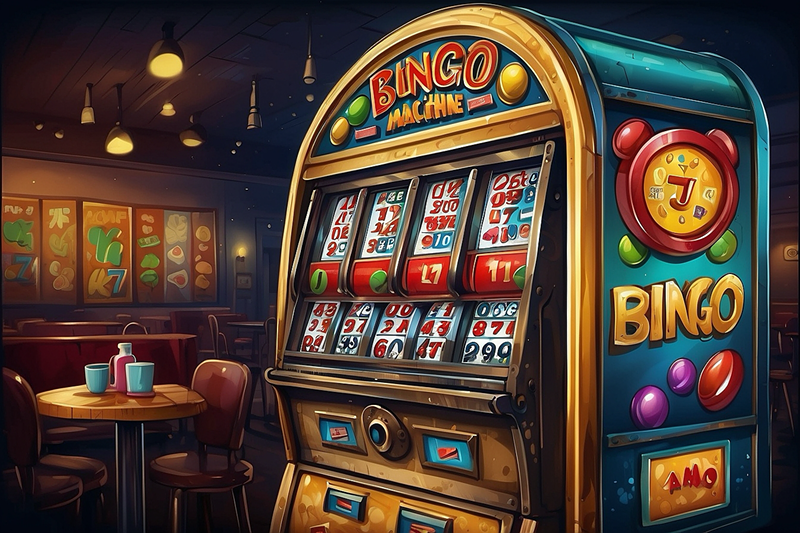Bingo is a game of chance where players match numbers printed in different arrangements on bingo cards to numbers that are drawn randomly by a caller. The standard bingo card is a grid consisting of rows and columns of squares, each typically containing a number. Players mark off numbers on their cards as they are called out, aiming to achieve a predetermined pattern to win.
- 90-ball bingo: This version, popular in the UK, uses cards with 15 numbers over three rows.
- 75-ball bingo: Predominant in North America, players have a 5x5 grid with a center 'free' space.
- 80-ball bingo: A less common variant featuring a 4x4 grid, bridging the gap between 75-ball and 90-ball bingo.
- 30-ball bingo: A speedier option, this game utilizes a 3x3 grid, making it ideal for quicker rounds.
To win, a player needs to complete a line or pattern as specified by the game rules. In some bingo games, achieving a "full house" or covering all numbers on the card leads to a jackpot.
Types of Bingo Games
There are several types of bingo games, each with its own set of rules and patterns. These bingo variations bring a unique twist to the gameplay experience, appealing to different preferences and skill levels.
- Traditional Games: Offer classic patterns like single lines, columns, or diagonal lines.
- Special Patterns: Involve complex shapes, letters of the alphabet, or thematic designs.
- Blackout Bingo: Requires covering all the spots on your card.
Each bingo game's complexity and winning criteria can vary, thereby affecting the pace and excitement of the game. It's crucial for players to familiarize themselves with the specific rules and patterns of the bingo variation they choose to play.
Getting Ready to Play
Before embarking on the game of Bingo, players must gather the necessary cards and equipment and understand how to set up the game, whether playing at home or on an online platform.
Bingo Cards and Equipment
Bingo cards are central to the game. Each player needs at least one card to participate, which come in various grids such as 3x3, 4x4, 5x5, or the traditional 9x3 configuration. The numbers on these cards are typically within the range of 1-75 for standard American bingo or 1-90 for the British version. Alongside the cards, players will require markers, also known as Bingo chips, to cover the called numbers. These can be any small item, from poker chips to coins or small pieces of paper.
Setting Up the Game at Home
When playing at home, one player assumes the role of the caller. This individual is responsible for randomly selecting numbers and announcing them to the players. All participating players should have their scorecards and chips ready. The game setup should include a method of randomly selecting bingo numbers, which can be accomplished with a bag of numbered pieces of paper, a rotating drum, or an electronic number generator.
Online Bingo Platforms
Playing Bingo online has become increasingly popular and is facilitated by numerous online casinos and specialized bingo websites. Players should choose a reputable site and ensure they have a stable internet connection. On these platforms, users typically purchase cards before a game starts. They can then decide whether to mark the cards manually or use the auto-daub feature provided by the program, which automatically marks off called numbers. This allows for a more relaxed game, enabling players to engage in multiple games concurrently or socialize in chat rooms without missing a number.
Rules of the Game
Bingo is a game of chance that is straightforward but requires attentiveness and familiarity with its rules and patterns to enhance the chances of winning.
Understanding Bingo Rules
In the traditional game of Bingo, each player receives a scorecard, which typically consists of a 5x5 grid of numbers. Bingo rules stipulate that each column on this card is represented by the letters B-I-N-G-O, with a range of numbers under each letter. In the center of the grid, there is a free space, which all players can immediately daub. The game progresses as the caller randomly selects and announces letter-number combinations, such as B12 or N39, and players must quickly daub the corresponding spaces on their scorecards.
Pattern Recognition and Winning Criteria
To win at Bingo, a player must be the first to complete a specified pattern on their scorecard and call out "Bingo!" Common winning patterns include any horizontal, vertical, or diagonal row, the four corners, or a specific shape, such as the letter X. A more challenging win is known as a full house, which requires all numbers on the scorecard to be marked off. Recognition of these patterns and swift action in marking the numbers are vital for securing victory.
Special Bingo Rules for Variations
Variations of the traditional Bingo game often have unique rules and patterns. For example:
- 75-ball bingo: Typically played in North America, this variation uses a 5x5 grid with a free space in the center. Each column corresponds with the B-I-N-G-O letters and contains a range of numbers:
- B: 1-15
- I: 16-30
- N: 31-45
- G: 46-60
- O: 61-75
- 90-ball bingo: Popular in Europe and Australia, players use a 9x3 card with 5 numbers and 4 blank spaces in each row. Winning patterns include any single line, two lines, and a full house.
- Some games introduce special winning patterns or even jackpot numbers that add an extra level of excitement and challenge. Rules for each variation should be clarified before the start of the game to ensure all players are aware of the winning criteria.
Playing the Game
Bingo is a game of chance where players mark off numbers on a scorecard as they are called out, aiming to achieve a specific pattern. The game requires concentration, and while no strategy guarantees a win, understanding game mechanics can enhance the experience.
The Role of the Caller
The caller plays a pivotal role in Bingo by selecting numbers at random and announcing them to players. Each number called is clearly articulated, often accompanied by a traditional phrase for clarity. It is the caller's duty to ensure a fair and enjoyable game by maintaining a consistent pace and verifying winning scorecards.
Gameplay Dynamics
During the game, players must pay close attention as each number is announced. They then daub, or mark off, the corresponding number on their scorecard if it is present. The central square on the scorecard is typically a free space, given to all players as a head start. The primary goal is to complete a predetermined pattern on the scorecard, which could be a line, a full house, or another pattern. The gameplay is straightforward:
- Listen to the caller.
- Daub the number if it's on your scorecard.
- Shout "Bingo" as soon as you complete the pattern.
Playing Strategically
While largely a game of luck, players can adopt certain strategies to slightly improve their chances of winning. Opting to play with multiple scorecards can increase the probability of having the called numbers, albeit at the cost of divided attention. Learning to play with keen concentration and managing several scorecards effectively is part of developing one's skill in Bingo. Moreover, playing in games with fewer players can increase the odds of winning since there is less competition.
Online Bingo Experience
Online bingo offers the convenience of playing from anywhere with an internet connection. Through a variety of platforms, players can enjoy a digital version of the classic game, complete with unique features and incentives.
Choosing the Right Platform
When selecting an online bingo site, one must look for a reputable platform that is known for its reliability and user-friendly interface. They should ensure the site's security measures are robust to protect personal and financial information. A good platform will offer a variety of bingo games and additional options like slots or live dealer games.
- Safety: SSL encryption, licensed operation
- Variety: Multiple bingo versions, side games
- User Experience: Intuitive design, easy navigation
Features of Online Play
Online play in bingo includes features that enhance gameplay, such as auto-daub which automatically marks off called numbers on the card. Online versions also often allow for multi-card play, increasing a player's chances to win. Chat functions enable social interaction, recreating the communal atmosphere of bingo halls.
- Auto-Daub: Automatically marks numbers
- Multiple Cards: Play with more than one card
- Chat Feature: Socialize with other players
Bonuses and Perks
On joining online casinos or bingo sites, players are often greeted with bonuses such as welcome offers or first deposit matches. These perks give players extra value and more opportunities to play. Loyalty programs and regular promotions keep the experience rewarding over time.
- Welcome Offers: Bonus funds on account creation
- Deposit Matches: Additional funds matching the deposit
- Loyalty Rewards: Points or credits for regular play
Communal Aspects of Bingo
Bingo is not just a game of chance; it's a vibrant social activity that connects individuals in various settings, from traditional bingo halls to the digital realm of online gaming.
Bingo Halls and Social Play
In bingo halls, players gather to participate in a game that has been cherished for generations. These venues offer more than just a chance to win; they are hubs of social interaction. Individuals from all walks of life come together, fostering a sense of community and shared enjoyment. The environment in bingo halls is typically one of camaraderie and fun, where regulars become a familiar sight, and newcomers are welcomed into the fold.
- Community Building: Bingo halls serve as social anchors in many communities, offering a place to meet friends and make new ones.
- Cultural Significance: Often, bingo nights are accompanied by other communal activities, including fundraising events and communal meals.
Playing Bingo with Friends Online
Moving from the physical space to the digital, playing bingo with friends online has redefined social play. Online bingo platforms offer various ways for friends to connect and play together, even when miles apart. Players can join virtual rooms, chat in real time, and share the excitement of the game, mimicking the social experience of a bingo hall.
- Accessibility: Online bingo is accessible from anywhere with an internet connection, expanding the game's reach beyond local community boundaries.
- Variations of Play: Different online bingo sites provide unique experiences, from themed games to unique bingo card designs, attracting a diverse range of players and fostering online communities.
Expanding Your Bingo Knowledge
Advanced Techniques and Creative Play
In Bingo, creative play and advanced strategies can afford players a competitive edge. While the numbers called are random, experienced players employ concentration and a keen sense of timing when daubing their cards. They often play multiple cards simultaneously to increase their chances of winning. This practice requires intense focus and quick reflexes to track all the called numbers efficiently.
Variations in the types of bingo games can include different patterns required for a win, such as standard lines, four corners, or more complex configurations. Understanding these patterns and anticipating which numbers are needed can inform a player's decision to play certain cards.
Historical and Cultural Context
Bingo's origins are traced to a lotto game in Italy during the 16th century. Over time, it evolved and spread across Europe, eventually reaching North America. The game's historical development is tied to cultural shifts and adoptive changes in different societies, where it has often been used for fundraising and social gatherings.
Different cultures have given rise to types of bingo games, each presenting its unique flavors and styles. For instance, the UK version utilizes 90 balls and typically employs three horizontal lines and nine columns, whereas the American variant predominantly uses 75 balls with a 5x5 card format.
The global evolution of Bingo reflects its adaptability and the ability of societies to infuse the game with local traditions while maintaining the core components that make it recognizable and universally enjoyable.
Safety and Responsible Play
When engaging in any game of chance like bingo, safety and responsible play are paramount. These elements ensure that the game remains an enjoyable activity and does not lead to financial strain or legal issues.
Setting a Gaming Budget
One's gaming budget should be determined before participation. It is essential that players only use funds they can afford to lose. Setting a clear budget helps avoid the pitfalls of overspending, as bingo, while entertaining, can be unpredictable.
- Determine your disposable income: Calculate the amount of money left after paying all necessary bills and saving a portion.
- Set strict limits: Choose a precise amount dedicated to gaming and do not exceed this limit.
- Record spending: Keep track of how much money is spent on bingo cards or online play.
Understanding Bingo and Gambling Regulations
Players must familiarize themselves with the rules and regulations governing bingo in their jurisdiction. Bingo is considered a form of gambling and is subject to various legal stipulations.
- Age restrictions: Confirm the legal age for gambling to ensure compliance with local laws.
- Game rules: Understand the specific bingo rules as they can vary by location and venue.
- Legal guidelines: Research what the law says about gambling in your area to play responsibly.
- Safety practices: Engage in bingo through reputable venues or web platforms to protect against potential fraud.
Bingo for Different Audiences
Bingo, a game enjoyed across generations, can be tailored to both entertain and educate various audiences, particularly when considering the interests and capacities of children, as well as the game’s potential in educational settings.
Bingo Adaptations for Children
For children, Bingo can be a captivating game when it incorporates vibrant images and symbols instead of traditional numbers. This modification not only holds their attention but also helps with recognition and cognitive association skills. The bingo cards might feature:
- Animals (Pictures of pets, wildlife)
- Colors (Color blocks or objects representing primary and secondary colors)
- Shapes (Circles, squares, triangles, etc.)
| Bingo Card Feature | Purpose |
| Pictures of fruits | Teaches food recognition |
| Simple words | Enhances reading ability |
Children's bingo cards may also use fewer grid spaces, such as a 3x3 grid, to maintain simplicity and a quicker pace conducive to shorter attention spans.
Bingo in Educational Settings
In the realm of education, Bingo can be an effective learning tool by utilizing words, mathematical problems, or foreign language terms. Teachers might craft the game to support learning objectives such as:
- Vocabulary expansion
- Math skill practice (e.g., equations in the squares, answers are called out)
- Language proficiency (words in the target language)
Not only does this make learning interactive and fun, but it can also encourage memory retention and active engagement. Adapted bingo games for education might feature:
- Math Bingo: Problem in the call-out, answer on the card
- Language Bingo: A word called out, its synonym or antonym on the card
- Science Bingo: Symbols or element names for chemistry learning
| Bingo Variation | Educational Goal |
| Synonym Bingo | Develop language skills |
| History Bingo | Teach historical facts |
| Nature Bingo | Reinforce ecological literacy |
Technical Aspects of Bingo
Bingo is underpinned by both physical equipment and sophisticated software that ensure gameplay is fair, random, and adheres to the classic experience of the game.
Bingo Machines and Software
Bingo machines and software are essential for the operation of a bingo game. The equipment varies from traditional mechanical blowers that mix and dispense balls to modern electronic systems that integrate technology and software. For physical games, the bingo machine is a central feature, physically drawing numbered balls at random which are then called out by a bingo caller. In online formats, software and programs replace physical components.
Physical bingo machine characteristics:
- Durability: Designed to withstand frequent use.
- Visibility: Clear displays for audibly and visually confirmed numbers.
Online bingo software features:
- Interface: Simple, intuitive interfaces for players.
- Auto-Daub: Automatic number marking on cards, freeing players to enjoy the social aspects of the game.
Understanding Random Number Generation
Random number generation (RNG) is the backbone of bingo's fairness, ensuring each number called is the result of chance. Physical machines mimic this randomness through the use of mixed balls, but in electronic bingo, RNG algorithms take on this role.
Characteristics of RNG in bingo:
- Unpredictability: RNG algorithms are designed to produce results that cannot be anticipated.
- Regular Auditing: Software systems are often audited to affirm that the RNG is functioning correctly and to sustain trust in the game's integrity.
Bingo for Entertainment
Bingo isn't just a game; it's a vibrant part of entertainment culture enjoyed in various social settings, offering fun and engaging moments for people of all ages. From themed parties to pop culture references, bingo has secured its place as an entertaining pastime with a multitude of creative adaptations.
Bingo in Popular Culture
Bingo has made its mark in pop culture, often portrayed in movies, TV shows, and novels as a communal activity that brings people together. Theme nights and bingo celebrations in popular media embody the game's capacity to adapt to different audiences and occasions. Notable depictions of bingo in pop culture serve to reinforce its popularity and versatility as a form of entertainment that resonates with a wide audience.
- Examples:
- Movies with bingo scenes that highlight a sense of community or serve as a setting for character interactions.
- TV show episodes that revolve around a game of bingo, often with comedic or dramatic twists.
Alternative Bingo Games and Events
Bingo's adaptability has led to an array of alternative bingo games and events, such as speed bingo, where the pace is quickened for a more thrilling experience. Bingo nights can feature unique themes or variations to keep the game fresh and exciting. These can range from holiday-themed bingo cards to events with music, lights, and decorations that transform traditional bingo halls into spaces of festive celebration.
- Variations:
- Musical Bingo: Replacing numbers with song snippets, players mark their cards when they recognize the tune.
- Costume Bingo: Participants dress up according to the theme, and bingo calls may be integrated into the theme.
Frequently Asked Questions
In this section, you'll find straightforward answers to common queries about the classic game of Bingo.
What are the essential rules for playing Bingo?
Players mark off numbers on cards as the numbers are called randomly by a caller. The first person to mark off the numbers in a specific pattern or line shouts "Bingo!" and, typically, wins the game.
Can you explain the basic setup for a Bingo game?
Each player needs at least one bingo card featuring a grid filled with numbers. A caller then draws numbers at random, either from a bag of physical balls or an electronic number generator.
How does one win at Bingo?
A player wins by being the first to complete a predetermined pattern on their bingo card with marked numbers. Patterns can be a line, a specific shape, or a full-house, where all numbers on the card are marked.
What variations exist for playing Bingo with words or numbers?
Variations include traditional number Bingo using different sized grids such as 3x3, 4x4, or 5x5, and themed Bingo variations that substitute numbers for words, images or phrases relevant to the game's theme.
Could you guide me through the process of playing Bingo online?
When playing Bingo online, one registers at a website providing bingo games, purchases virtual cards, and marks numbers that are called out on the screen. Many online Bingo games mark the cards automatically.
What are some tips for beginners learning to play Bingo?
Beginners should start with a small number of cards to keep track of the game easily. They should also familiarize themselves with the various patterns needed to win in the specific Bingo game they are playing.
For more information please contact us: [email protected]






